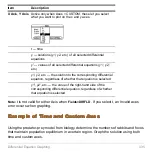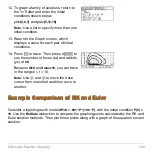
Differential Equation Graphing
425
Defining a System for Higher-Order Equations
Defining a System for Higher-Order Equations
Defining a System for Higher-Order Equations
Defining a System for Higher-Order Equations
In the Y= Editor, you must enter all differential equations as 1st-order equations. If you
have an nth-order equation, you must transform it into a system of n 1st-order equations.
Transforming an Equation into a 1st-Order System
Transforming an Equation into a 1st-Order System
Transforming an Equation into a 1st-Order System
Transforming an Equation into a 1st-Order System
A system of equations can be defined in various ways, but the following is a general
method.
1. Rewrite the original differential equation
as necessary.
a) Solve for the highest-ordered
derivative.
b) Express it in terms of y and t.
c) On the right side of the equation only,
substitute to eliminate any references
to derivative values.
Note:
To produce a 1st-order equation,
the right side must contain non-derivative
variables only.
y'' + y' + y = e
x
y'' =
e
t
N
y'
N
y
y'' =
e
x
N
y'
N
y
Summary of Contents for Voyage 200
Page 36: ...Getting Started 36 D B D B Press Result ...
Page 45: ...Getting Started 45 3 0 D B D D B D Press Result ...
Page 46: ...Getting Started 46 D 2 0 0 2 D B Scroll down to October and press Press Result ...
Page 60: ...Getting Started 60 B D Press Result ...
Page 139: ...Previews 139 8 Complete the operation Press 2 d Steps and keystrokes Display 5 f 2 ...
Page 453: ...Differential Equation Graphing 453 ...
Page 468: ...Tables 468 ...
Page 777: ...Activities 777 ...












































